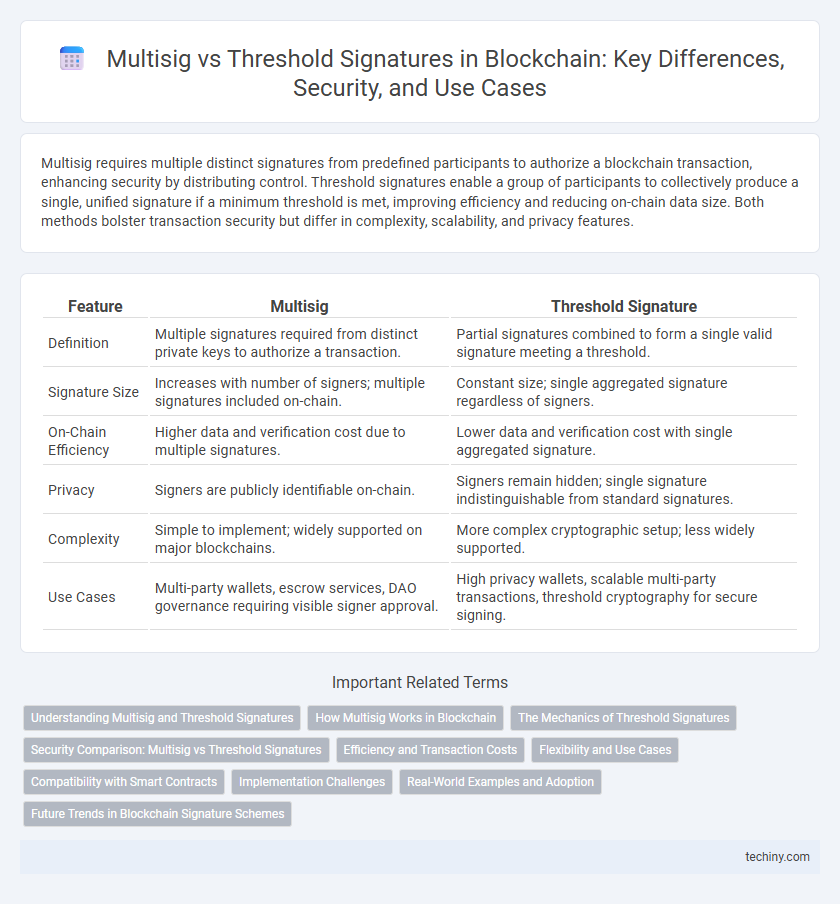Multisig requires multiple distinct signatures from predefined participants to authorize a blockchain transaction, enhancing security by distributing control. Threshold signatures enable a group of participants to collectively produce a single, unified signature if a minimum threshold is met, improving efficiency and reducing on-chain data size. Both methods bolster transaction security but differ in complexity, scalability, and privacy features.
Table of Comparison
| Feature | Multisig | Threshold Signature |
|---|---|---|
| Definition | Multiple signatures required from distinct private keys to authorize a transaction. | Partial signatures combined to form a single valid signature meeting a threshold. |
| Signature Size | Increases with number of signers; multiple signatures included on-chain. | Constant size; single aggregated signature regardless of signers. |
| On-Chain Efficiency | Higher data and verification cost due to multiple signatures. | Lower data and verification cost with single aggregated signature. |
| Privacy | Signers are publicly identifiable on-chain. | Signers remain hidden; single signature indistinguishable from standard signatures. |
| Complexity | Simple to implement; widely supported on major blockchains. | More complex cryptographic setup; less widely supported. |
| Use Cases | Multi-party wallets, escrow services, DAO governance requiring visible signer approval. | High privacy wallets, scalable multi-party transactions, threshold cryptography for secure signing. |
Understanding Multisig and Threshold Signatures
Multisig requires multiple distinct signatures from a predefined group of participants to authorize a transaction, enhancing security by distributing signing authority. Threshold signatures enable a flexible approach where any subset of a minimum number of participants can jointly produce a single, unified signature, improving efficiency and privacy. Both methods provide robust decentralized control but differ in signature aggregation and operational complexity.
How Multisig Works in Blockchain
Multisig in blockchain requires multiple private keys to authorize a single transaction, enhancing security by distributing signing authority among participants. Each participant generates a distinct signature, which, when combined, validate the transaction according to pre-defined rules such as "M-of-N" signatures needed for approval. This system prevents unauthorized transactions by ensuring that no single party can unilaterally control funds or execute changes without consensus.
The Mechanics of Threshold Signatures
Threshold signatures enable a group of participants to collectively generate a single digital signature, where only a predefined minimum number of members (the threshold) must cooperate to sign a message. This cryptographic mechanism divides the private key into shares, ensuring no single entity holds the entire key, enhancing security and fault tolerance compared to traditional multisig setups. By leveraging schemes like Shamir's Secret Sharing and distributed key generation, threshold signatures streamline transaction verification on blockchain networks while reducing transaction size and improving privacy.
Security Comparison: Multisig vs Threshold Signatures
Multisig requires multiple distinct signatures for transaction approval, enhancing security by preventing single-point failures but can be vulnerable to key leakage if individual keys are compromised. Threshold signatures use cryptographic protocols to generate a single aggregated signature from multiple parties, reducing on-chain data and improving privacy while maintaining robust fault tolerance against rogue participants. Both methods increase security over single-signature schemes, but threshold signatures offer stronger resistance to collusion and key exposure risks due to their distributed key generation and signature aggregation processes.
Efficiency and Transaction Costs
Multisig wallets require multiple individual signatures to validate a transaction, often leading to larger transaction sizes and higher associated fees on blockchain networks. Threshold signature schemes aggregate multiple partial signatures into a single compact signature, significantly reducing the on-chain data footprint and lowering transaction costs. The efficiency of threshold signatures compared to traditional multisig makes them preferable for scalable and cost-effective blockchain applications.
Flexibility and Use Cases
Multisig requires multiple distinct signatures from a predefined subset of private keys, offering straightforward transaction authorization ideal for secure wallets and corporate accounts. Threshold signature schemes enable flexible signature aggregation, allowing any subset of participants to jointly produce a single compact signature, enhancing scalability and privacy for decentralized applications and consortium blockchains. This flexibility in threshold signatures supports dynamic participant changes without revealing the signer subset, making it suitable for evolving multi-party business models.
Compatibility with Smart Contracts
Multisig wallets require multiple distinct signatures on-chain, making them natively compatible with most smart contract platforms such as Ethereum and Binance Smart Chain. Threshold signature schemes aggregate multiple private keys off-chain to produce a single signature, improving efficiency but often necessitating specialized contract logic or extensions to verify aggregated signatures. Evaluating compatibility involves considering the blockchain's native support for signature aggregation and whether smart contracts can validate threshold signatures without compromising security or incurring excessive gas costs.
Implementation Challenges
Multisig wallets require multiple independent signatures, leading to complexities in key management and transaction coordination that can increase latency and user errors. Threshold signature schemes, while offering more efficient and compact signatures, demand sophisticated cryptographic protocols and secure distributed key generation, creating higher implementation barriers. Both approaches face challenges in achieving seamless interoperability and robust security against key compromise in decentralized environments.
Real-World Examples and Adoption
Multisig wallets, used by Bitcoin and Ethereum projects, require multiple private keys to authorize transactions, enhancing security but often limiting scalability and user experience. Threshold signature schemes, adopted by platforms like Algorand and Dfinity, enable decentralized key management with similar security guarantees but improved efficiency and privacy by producing a single aggregated signature. Real-world adoption shows multisig remains popular for straightforward custody solutions, while threshold signatures gain traction in complex decentralized finance protocols and enterprise blockchain applications due to their scalability and reduced operational overhead.
Future Trends in Blockchain Signature Schemes
Threshold signature schemes are gaining traction over traditional multisig due to improved scalability and privacy in blockchain transactions. Future trends emphasize threshold signatures enabling seamless decentralized key management and reducing on-chain data, thereby enhancing overall network efficiency. Innovations in cryptographic protocols are expected to further strengthen security and interoperability across multi-party blockchain applications.
Multisig vs Threshold Signature Infographic

 techiny.com
techiny.com